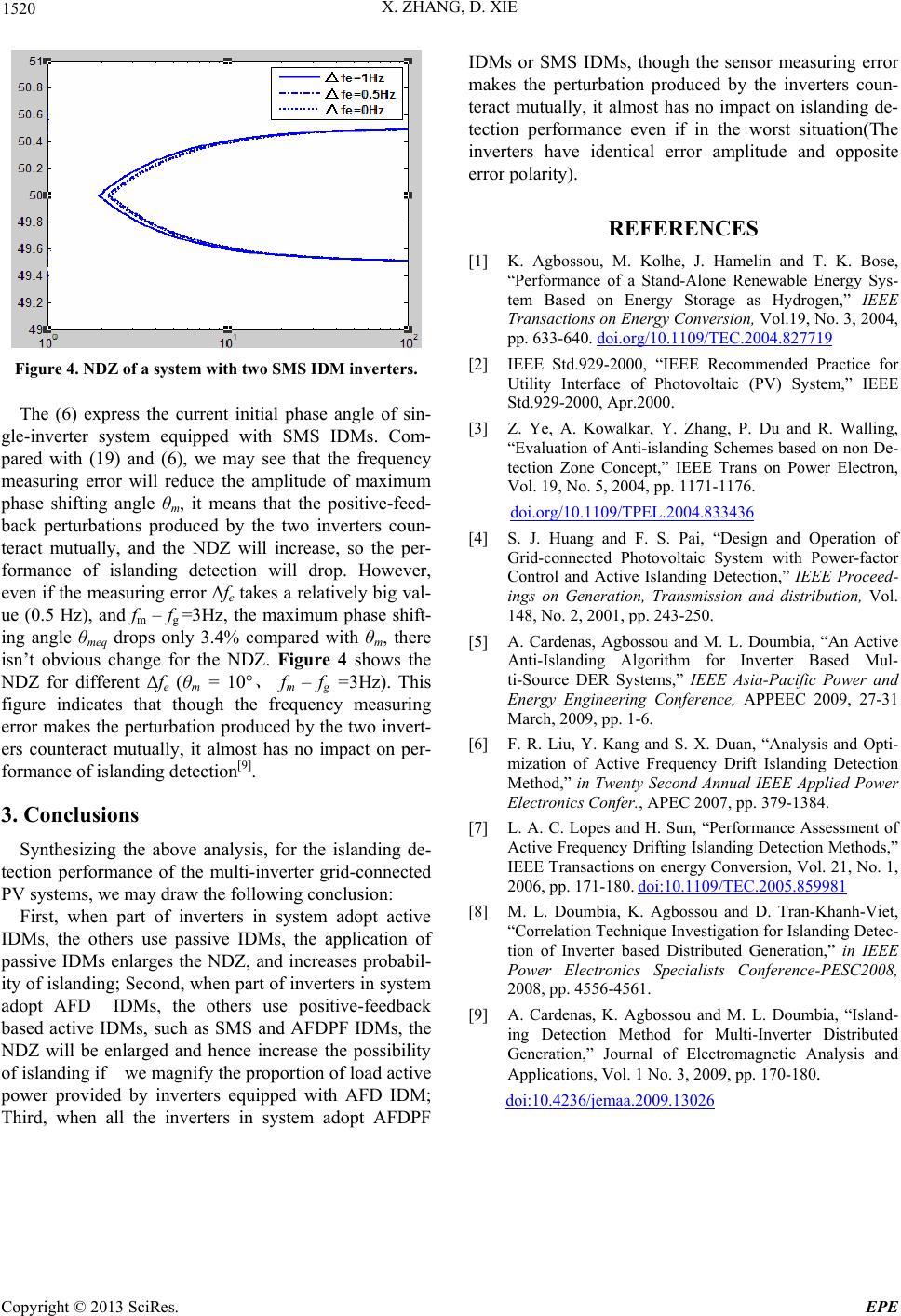
X. ZHANG, D. XIE
Copyright © 2013 SciRes. EPE
1520
Figure 4. NDZ of a system with two SMS IDM inverters.
The (6) express the current initial phase angle of sin-
gle-inverter system equipped with SMS IDMs. Com-
pared with (19) and (6), we may see that the frequency
measuring error will reduce the amplitude of maximum
phase shifting angle θm, it means that the positive-feed-
back perturbations produced by the two inverters coun-
teract mutually, and the NDZ will increase, so the per-
formance of islanding detection will drop. However,
even if the measuring error Δfe takes a relatively big val-
ue (0.5 Hz), and fm – fg =3Hz, the maximum phase shift-
ing angle θmeq drops only 3.4% compared with θm, there
isn’t obvious change for the NDZ. Figure 4 shows the
NDZ for different Δfe (θm = 10°
、
f
m – fg =3Hz). This
figure indicates that though the frequency measuring
error makes the perturbation produced by the two invert-
ers counteract mutually, it almost has no impact on per-
formance of islanding detection[9].
3. Conclusions
Synthesizing the above analysis, for the islanding de-
tection performance of the multi-inverter grid-connected
PV systems, we may draw the following conclusion:
First, when part of inverters in system adopt active
IDMs, the others use passive IDMs, the application of
passive IDMs enlarges the NDZ, and increases probabil-
ity of islanding; Second, when part of inverters in system
adopt AFD IDMs, the others use positive-feedback
based active IDMs, such as SMS and AFDPF IDMs, the
NDZ will be enlarged and hence increase the possibility
of islanding if we magnify the proportion of load active
power provided by inverters equipped with AFD IDM;
Third, when all the inverters in system adopt AFDPF
IDMs or SMS IDMs, though the sensor measuring error
makes the perturbation produced by the inverters coun-
teract mutually, it almost has no impact on islanding de-
tection performance even if in the worst situation(The
inverters have identical error amplitude and opposite
error polarity).
REFERENCES
[1] K. Agbossou, M. Kolhe, J. Hamelin and T. K. Bose,
“Performance of a Stand-Alone Renewable Energy Sys-
tem Based on Energy Storage as Hydrogen,” IEEE
Transactions on Energy Conversion, Vol.19, No. 3, 2004,
pp. 633-640. doi.org/10.1109/TEC.2004.827719
[2] IEEE Std.929-2000, “IEEE Recommended Practice for
Utility Interface of Photovoltaic (PV) System,” IEEE
Std.929-2000, Apr.2000.
[3] Z. Ye, A. Kowalkar, Y. Zhang, P. Du and R. Walling,
“Evaluation of Anti-islanding Schemes based on non De-
tection Zone Concept,” IEEE Trans on Power Electron,
Vol. 19, No. 5, 2004, pp. 1171-1176.
doi.org/10.1109/TPEL.2004.833436
[4] S. J. Huang and F. S. Pai, “Design and Operation of
Grid-connected Photovoltaic System with Power-factor
Control and Active Islanding Detection,” IEEE Proceed-
ings on Generation, Transmission and distribution, Vol.
148, No. 2, 2001, pp. 243-250.
[5] A. Cardenas, Agbossou and M. L. Doumbia, “An Active
Anti-Islanding Algorithm for Inverter Based Mul-
ti-Source DER Systems,” IEEE Asia-Pacific Power and
Energy Engineering Conference, APPEEC 2009, 27-31
March, 2009, pp. 1-6.
[6] F. R. Liu, Y. Kang and S. X. Duan, “Analysis and Opti-
mization of Active Frequency Drift Islanding Detection
Method,” in Twenty Second Annual IEEE Applied Power
Electronics Confer., APEC 2007, pp. 379-1384.
[7] L. A. C. Lopes and H. Sun, “Performance Assessment of
Active Frequency Drifting Islanding Detection Methods,”
IEEE Transactions on energy Conversion, Vol. 21, No. 1,
2006, pp. 171-180. doi:10.1109/TEC.2005.859981
[8] M. L. Doumbia, K. Agbossou and D. Tran-Khanh-Viet,
“Correlation Technique Investigation for Islanding Detec-
tion of Inverter based Distributed Generation,” in IEEE
Power Electronics Specialists Conference-PESC2008,
2008, pp. 4556-4561.
[9] A. Cardenas, K. Agbossou and M. L. Doumbia, “Island-
ing Detection Method for Multi-Inverter Distributed
Generation,” Journal of Electromagnetic Analysis and
Applications, Vol. 1 No. 3, 2009, pp. 170-180.
doi:10.4236/jemaa.2009.13026